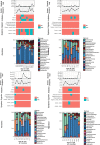Longitudinal development of the airway microbiota in infants with cystic fibrosis
- PMID: 30914718
- PMCID: PMC6435666
- DOI: 10.1038/s41598-019-41597-0
Longitudinal development of the airway microbiota in infants with cystic fibrosis
Abstract
The pathogenesis of airway infection in cystic fibrosis (CF) is poorly understood. We performed a longitudinal study coupling clinical information with frequent sampling of the microbiota to identify changes in the airway microbiota in infancy that could underpin deterioration and potentially be targeted therapeutically. Thirty infants with CF diagnosed on newborn screening (NBS) were followed for up to two years. Two hundred and forty one throat swabs were collected as a surrogate for lower airway microbiota (median 35 days between study visits) in the largest longitudinal study of the CF oropharyngeal microbiota. Quantitative PCR and Illumina sequencing of the 16S rRNA bacterial gene were performed. Data analyses were conducted in QIIME and Phyloseq in R. Streptococcus spp. and Haemophilus spp. were the most common genera (55% and 12.5% of reads respectively) and were inversely related. Only beta (between sample) diversity changed with age (Bray Curtis r2 = 0.15, P = 0.03). Staphylococcus and Pseudomonas were rarely detected. These results suggest that Streptococcus spp. and Haemophilus spp., may play an important role in early CF. Whether they are protective against infection with more typical CF micro-organisms, or pathogenic and thus meriting treatment needs to be determined.
Conflict of interest statement
The authors declare no competing interests.
Figures



References
Publication types
MeSH terms
Grants and funding
LinkOut - more resources
Full Text Sources
Medical
Research Materials
Miscellaneous

